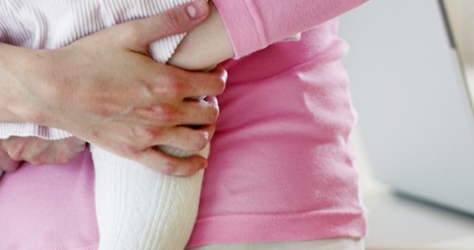Toddlers like to get themselves into sticky situations. For them it’s called exploring...
For you it’s keeping you on your toes and a couple of heart stopping moments when they find they can climb the bookcase – their version of Mount Everest. Here’s a guide to baby-proofing your home....
At a glance
- You'll need to protect your child from any sharp or hard edges that fall below your knee
- Buy plastic covers for all unused plug sockets
- Loose wires and power cables can be dangerous - check these regularly for damage

Top tips for baby-proofing
No-one wants to wrap their little explorer in cotton wool. But, even the liveliest of parents gets flattened by constantly sprinting over to stop their toddler poking their fingers in sockets, climbing on stools or grabbing at bottles.
To stop those hairs turning prematurely grey, there are a few measures you can take to baby-proof your home - so you can supervise from the luxury of the sofa.
Soften hard edges
It may look like an innocent piece of furniture, but for a toddler, a coffee table is an accident waiting to happen. In fact, any furniture that has hard sharp edges below knee-height are potentials for bangs on the head. You could take it extremes, banishing pointy furniture to the kingdom of the stupidly expensive hire storage unit. Or more realistically, you can save your pennies by investing in those highly affordable cushioned corner guards and edge protector strips.
Electrical outlets
The Royal Society for the Prevention of Accidents (RoSPA) explains that 13-amp power sockets made to BS 1363 incorporate a shutter mechanism, which prevents inappropriate access to the live connectors, therefore does not consider it necessary to recommend the use of socket covers.
Wiley wires
Little adventurers love the tangle potential of these loose wires, especially if they’re attached to heavy lamps, kettles and irons. You could move to sunnier climes and invest in everything solar-powered. Or you could just unplug some electrical appliances when you are not using them.
Never run leads or cables under carpets or rugs – you won't be able to see if they become damaged. And keep an eye out for signs of loose wiring, faulty plugs or sockets - scorch marks or flickering lights are warning signs. Always replace worn, damaged or taped up leads and cables.
Safe stairs
Stairs are a truly exciting challenge for your budding Ranulph Fiennes. So you could take it to the extreme - moving to a bunglalow or employing a 24-hour guard to man the stairs. Or you could just buy stair-gates. There are various styles on offer, including those which can be slotted into a space without the need for drilling any holes.
Lock kitchen cupboards
To little imaginations, opening up those kitchen cupboards is like taking the first steps into Narnia, with colourful bottles of bleach, dishwasher tablets and sprays just begging to be played with.
You could arm your tot with gloves, an apron and goggles - it’s never too early to teach them about chemical reactions! Or more realistically you could just store all those household substances in a cupboard far away from prying hands, and snap on cupboard and draw locks.
Fires and heaters
Fires and toddlers do not mix. You could relocate your family to an igloo in Greenland - or you could just make your house fire-proof. Where kids and fires are both present, fireguards are required by law. It’s also a good idea to keep a fire-extinguisher in the house. Fit and regularly test smoke alarms to keep you and your family safe.
More information:
• Royal Society for the Prevention of Accidents
• Child Accident Prevention Trust
• Directgov child safety site